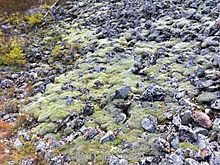Dump

Block heaps are large accumulations of stone blocks with diameters almost exclusively over 20 cm on slopes, which are frost-marked (periglacial) either directly below the current snow line ( solifluction stage ) or represent a relic of forms that emerged during the Ice Age . Due to their warmth, dryness and the lack of fine material, they are a special habitat for animals and plants. Some block heaps, especially those used for tourism, are generally referred to as rock seas or block seas , and if they are elongated, also as rock rivers (e.g. in the Vitosha Mountains ).
Block heaps arise through physical weathering , more precisely through frost blasting of very hard rock (e.g. granite , limestone or quartzite ), and are sorted through the rock elevation in the process of solifluction . The rocks are arranged by gravity in larger blocks and smaller gravel and sand fractions , so that the smaller fractions are below or in front of the blocks.
Difference to the scree slope
Because of this type of formation, the block heaps - in contrast to rubble or scree heaps (geological talus ) - lack gravel and sand. This means that water can run off quickly and that blown humus is soon washed away. On the other hand, on rocks there are crevices or ledges in which fine soil can collect. Therefore, the habitats are very different, so that there is a completely different vegetation. Often there is almost no plant life on the block heap except for algae , moss and lichens .
Since block heaps were accumulated solely by gravity, they have a higher gradient than block seas washed up by water . For this reason and because of the large, irregular spaces between the individual blocks, walking on such heaps is dangerous; at Semmering (see 1st picture) it has already led to several mountain accidents .
Some rock heaps are the remains of former rock glaciers , such as the Schafstein .
Ice formation
In some cases there is another special feature that leads to even more special habitats: there is a large amount of ice in the block dump, which can also be a relic of the former block glacier. In winter there is an air flow through the block heap, with the cold air flowing in at the bottom and warmed out at the top of the heap. The inside of the heap cools down and the amount of ice increases. In summer the air flow is reversed: the warm air penetrates the heap at the top, cools down and flows out again at the bottom of the heap. These cold air outlets are sometimes clearly noticeable if ice can stick to these outlets for a long time until summer. In order for this effect to be possible, the temperature differences must be as large as possible. Therefore, the effect is hardly noticeable in spring and autumn. In addition, the ice with its latent heat ensures both the heat storage and the maintenance of a largely constant temperature inside, which increases the possible temperature differences to the outside.
The heat transport and the heat storage lead to two other special habitats: Plants that love warmth can grow on the upper part of the block heap, as this area is often kept free of ice in winter by the warmer air that escapes. In summer, on the other hand, warmer air is sucked in here, so that the rocks warm up more strongly and at greater depths and are thus warmer than the surroundings at night.
At the foot of the block heap, cool, moist air flows out in summer. Due to the constant moisture, so-called condensation bogs can form here. The growth of peat moss and other mosses is very abundant due to the high humidity. In addition, thanks to the cooler air, high mountain plants that were otherwise displaced from most areas of Central Europe after the Ice Age can assert themselves .
See also
literature
- Bodo M. Möseler, Roland Molenda (Eds.): Habitat Blockhalde. On the ecology of periglacial block heaps in Central Europe outside the Alps. Proceedings of the symposium on September 13 and 14, 1997 at the Friedrich Schiller University Jena (= Decheniana . Supplements 37, ISSN 0416-833X ). Self-published by the Natural History Association, Bonn 1999.
- Martin Gude, Roland Molenda: Block heaps in German low mountain ranges - relics of the ice ages. In: Institut für Länderkunde, Leipzig (Hrsg.): National Atlas Federal Republic of Germany. Volume 2: Relief, Soil and Water. Spectrum, Akademischer Verlag, Heidelberg et al. 2003, ISBN 3-8274-0953-5 , pp. 72-73.
- Martin Gude, Roland Molenda: rocks, block heaps, rubble heaps, scree fields. In: Werner Konold, Reinhard Böcker, Ulrich Hampicke (eds.): Handbook of nature conservation and landscape maintenance. XI-2.27. Wiley-VCH et al., Weinheim et al. 2003, pp. 1-9.
- Michael Lüth: Moss societies on block heaps in the southern Black Forest in the vicinity of Freiburg (= publications for nature conservation and landscape management in Baden-Württemberg. Supplements 58). State Institute for Environmental Protection Baden-Württemberg, Karlsruhe 1990, ISBN 3-88251-156-7 .
Web links
- Rocks and dumps
- Block heaps
- Rauher Kulm block dump
- Block heaps in the Fichtel Mountains
- Block heaps of the Saar-Hunsrück Nature Park
Individual evidence
- ↑ Spectrum Lexicon of Geography: Blockmeer.


